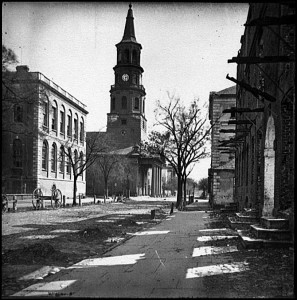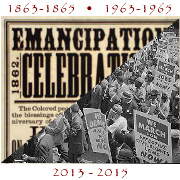Remember, Memorial Day was started by African-Americans
Posted May 27th, 2016 by James DeWolf PerryCategory: History Tags: Charleston S.C., Emancipation to Equality, Memorial Day, South Carolina, U.S. Civil War
In honor of Memorial Day, we are reposting this blog entry from 2013, which recounts how the first Memorial Day was celebrated by free black troops and civilians in Charleston, S.C. at the end of the Civil War.
 As we pause today to remember the nation’s war dead, it’s worth remembering that Memorial Day was first celebrated by black Union troops and free black Americans in Charleston, South Carolina at the end of the Civil War.
As we pause today to remember the nation’s war dead, it’s worth remembering that Memorial Day was first celebrated by black Union troops and free black Americans in Charleston, South Carolina at the end of the Civil War.
As historian David Blight recounts in his masterful book, Race and Reunion: The Civil War in American Memory (2001), Charleston was occupied by Union troops in the spring of 1865, most white residents having fled the city. In this atmosphere, the free black population of Charleston, primarily consisting of former slaves, engaged in a series of celebrations to proclaim the meaning of the war as they saw it.
The height of these celebrations took place on May 1, 1865, on the grounds of the former Washington Race Course and Jockey Club, an elite facility which had been used by the Confederates as a gruesome prison and mass grave for unlucky Union soldiers. Following the evacuation of Charleston, black laborers had dug up the remains of Union soldiers, given them a proper burial, and built the trappings of a respectful cemetery around the site to memorialize their sacrifice.
To dedicate the cemetery to the Union’s war dead, black and white leaders came together to organize a parade of 10,000 people, described in a New York Tribune account as “a procession of friends and mourners as South Carolina and the United States never saw before.” At the front of the parade were 3,000 black children, laden with roses and singing “John Brown’s Body,” while bringing up the rear were a brigade of Union troops, including the Massachusetts 54th Regiment and the 34th and 104th United States Colored Troops. (The commander of the 21st United States Colored Infantry had been the one to formally accept the city’s surrender.) Following the parade and dedication in the cemetery, the crowd settled down to picnic, listen to orators, and watch the troops march.
In the years to come, there would be many variations on Memorial (or “Decoration”) Day, before the nation settled on the holiday’s current form. These differences often reflected the competing visions of white northerners and southerners over how to remember the war, and there was generally little room in either vision for the meaning of the war for African-Americans.
But as Blight wrote in Race and Reunion, in its origins, Memorial Day was “founded by African Americans in a ritual of remembrance and consecration.” ((David W. Blight, Race and Reunion: The Civil War in American Memory (2001), p. 70.))



May 29th, 2016 at 9:19 pm
Thank you for this important reminder on the history of Memorial Day!
October 13th, 2016 at 12:05 pm
Thank you so much for your interpretive writings, consistent within your stated mission "… to educate the public about the history and legacy of race and other forms of discrimination, in order to change hearts and minds, foster dialogue, and encourage healing and justice." In my opinion, your writings simply reinforce the idea that our nation's virtues of freedom and liberty, however complex, stem from a mosaic of cultural and racial diversity which we all can be proud of, if we're fair about honoring our collective stories and struggles.
April 8th, 2017 at 7:30 am
There will be a Decoration Day of 1865 event that will take place at the original site of Hampton Park at 30 Mary Murray in Charleston, SC 29403 at 2:00. This will be a free event and all are invited. This will be a day to celebrate and to educate.